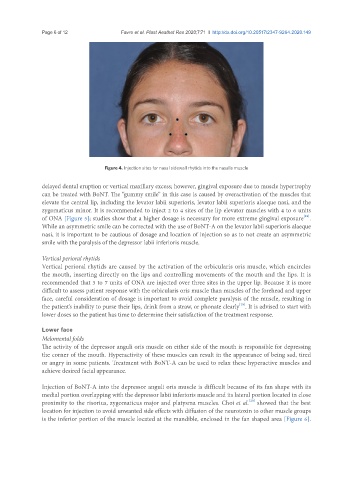Page 844 - Read Online
P. 844
Page 6 of 12 Favre et al. Plast Aesthet Res 2020;7:71 I http://dx.doi.org/10.20517/2347-9264.2020.149
Figure 4. Injection sites for nasal sidewall rhytids into the nasalis muscle
delayed dental eruption or vertical maxillary excess; however, gingival exposure due to muscle hypertrophy
can be treated with BoNT. The “gummy smile” in this case is caused by overactivation of the muscles that
elevate the central lip, including the levator labii superioris, levator labii superioris alaeque nasi, and the
zygomaticus minor. It is recommended to inject 2 to 4 sites of the lip elevator muscles with 4 to 6 units
[19]
of ONA [Figure 5]; studies show that a higher dosage is necessary for more extreme gingival exposure .
While an asymmetric smile can be corrected with the use of BoNT-A on the levator labii superioris alaeque
nasi, it is important to be cautious of dosage and location of injection so as to not create an asymmetric
smile with the paralysis of the depressor labii inferioris muscle.
Vertical perioral rhytids
Vertical perioral rhytids are caused by the activation of the orbicularis oris muscle, which encircles
the mouth, inserting directly on the lips and controlling movements of the mouth and the lips. It is
recommended that 3 to 7 units of ONA are injected over three sites in the upper lip. Because it is more
difficult to assess patient response with the orbicularis oris muscle than muscles of the forehead and upper
face, careful consideration of dosage is important to avoid complete paralysis of the muscle, resulting in
[16]
the patient’s inability to purse their lips, drink from a straw, or phonate clearly . It is advised to start with
lower doses so the patient has time to determine their satisfaction of the treatment response.
Lower face
Melomental folds
The activity of the depressor anguli oris muscle on either side of the mouth is responsible for depressing
the corner of the mouth. Hyperactivity of these muscles can result in the appearance of being sad, tired
or angry in some patients. Treatment with BoNT-A can be used to relax these hyperactive muscles and
achieve desired facial appearance.
Injection of BoNT-A into the depressor anguli oris muscle is difficult because of its fan shape with its
medial portion overlapping with the depressor labii inferioris muscle and its lateral portion located in close
[20]
proximity to the risorius, zygomaticus major and platysma muscles. Choi et al. showed that the best
location for injection to avoid unwanted side effects with diffusion of the neurotoxin to other muscle groups
is the inferior portion of the muscle located at the mandible, enclosed in the fan shaped area [Figure 6].

